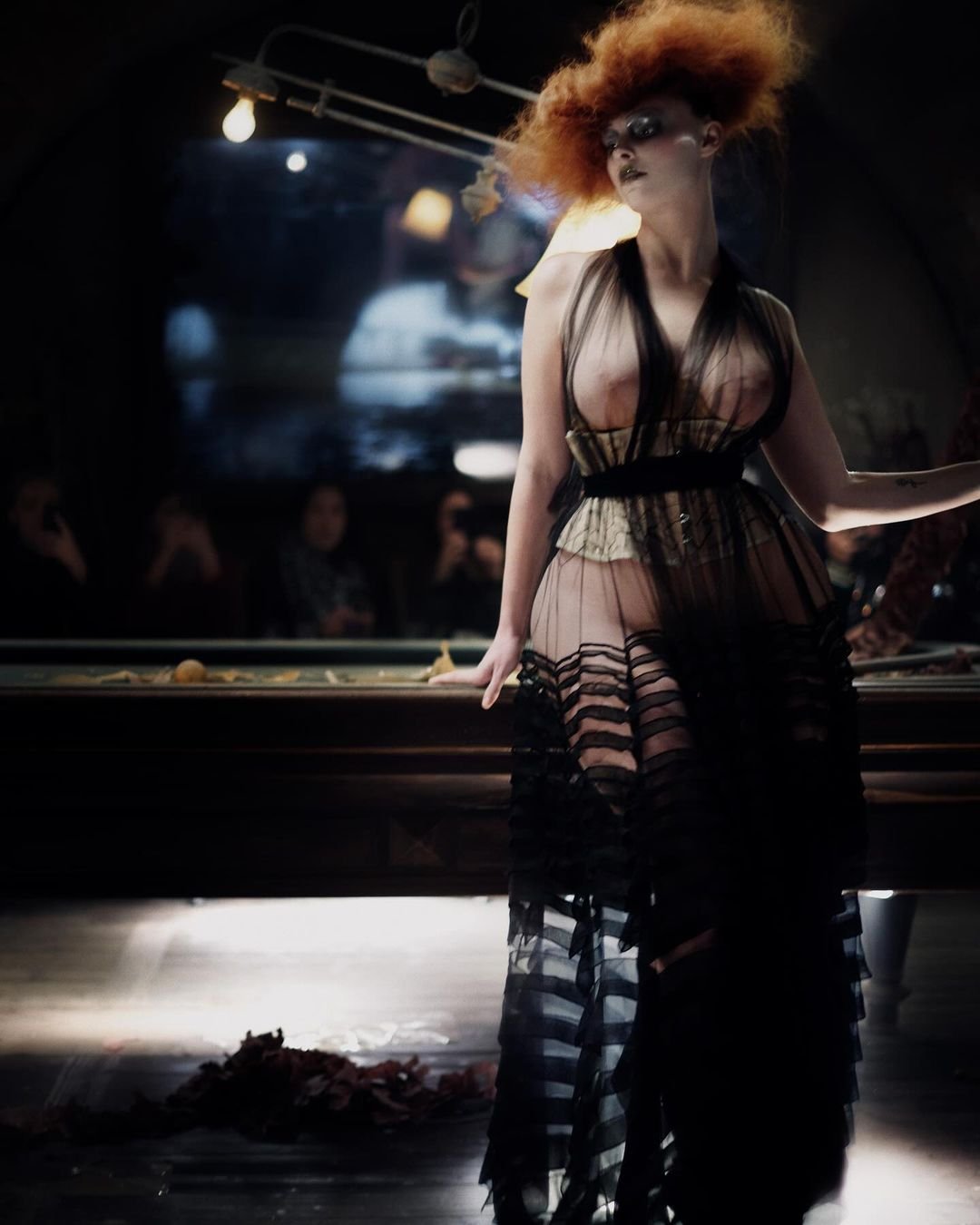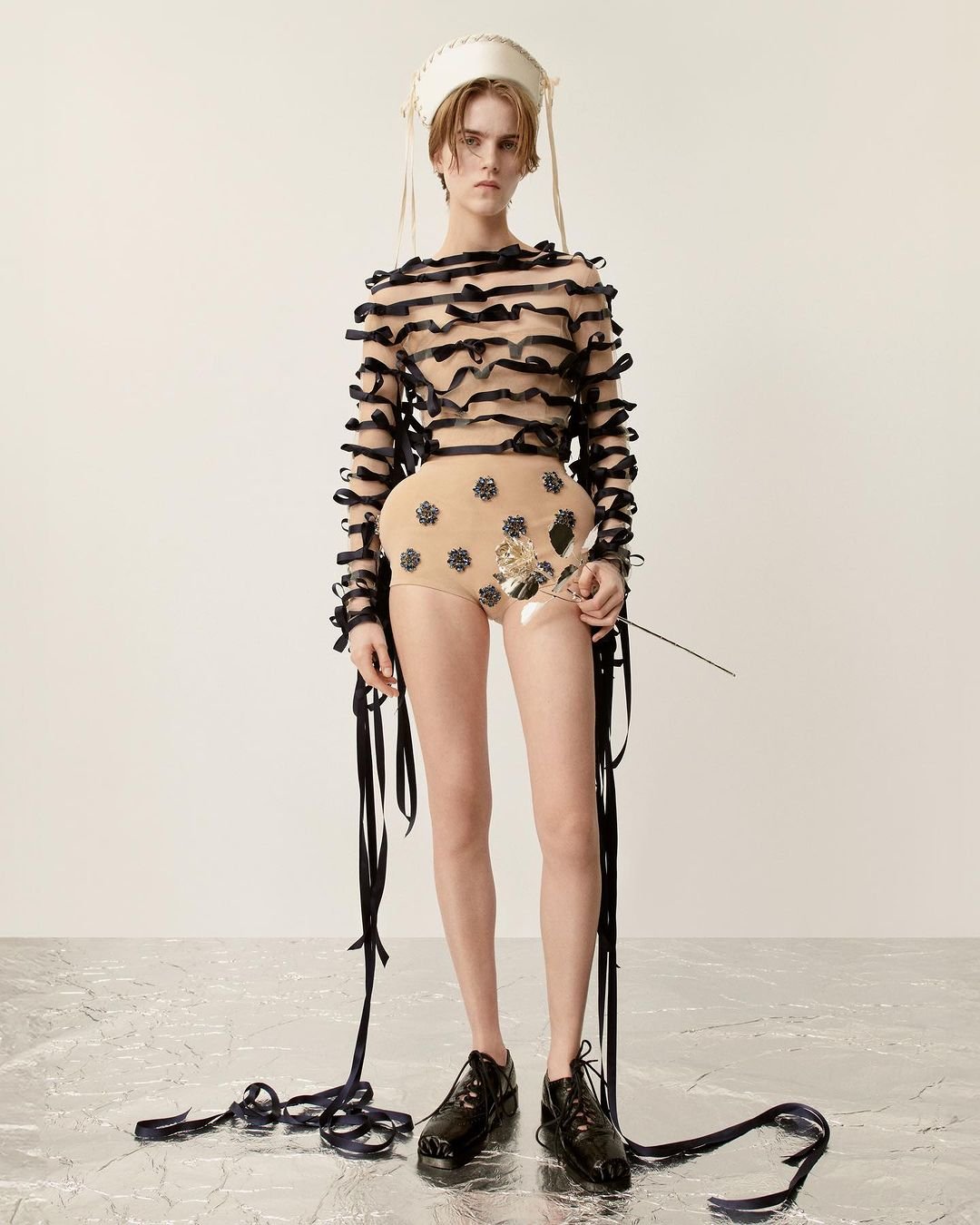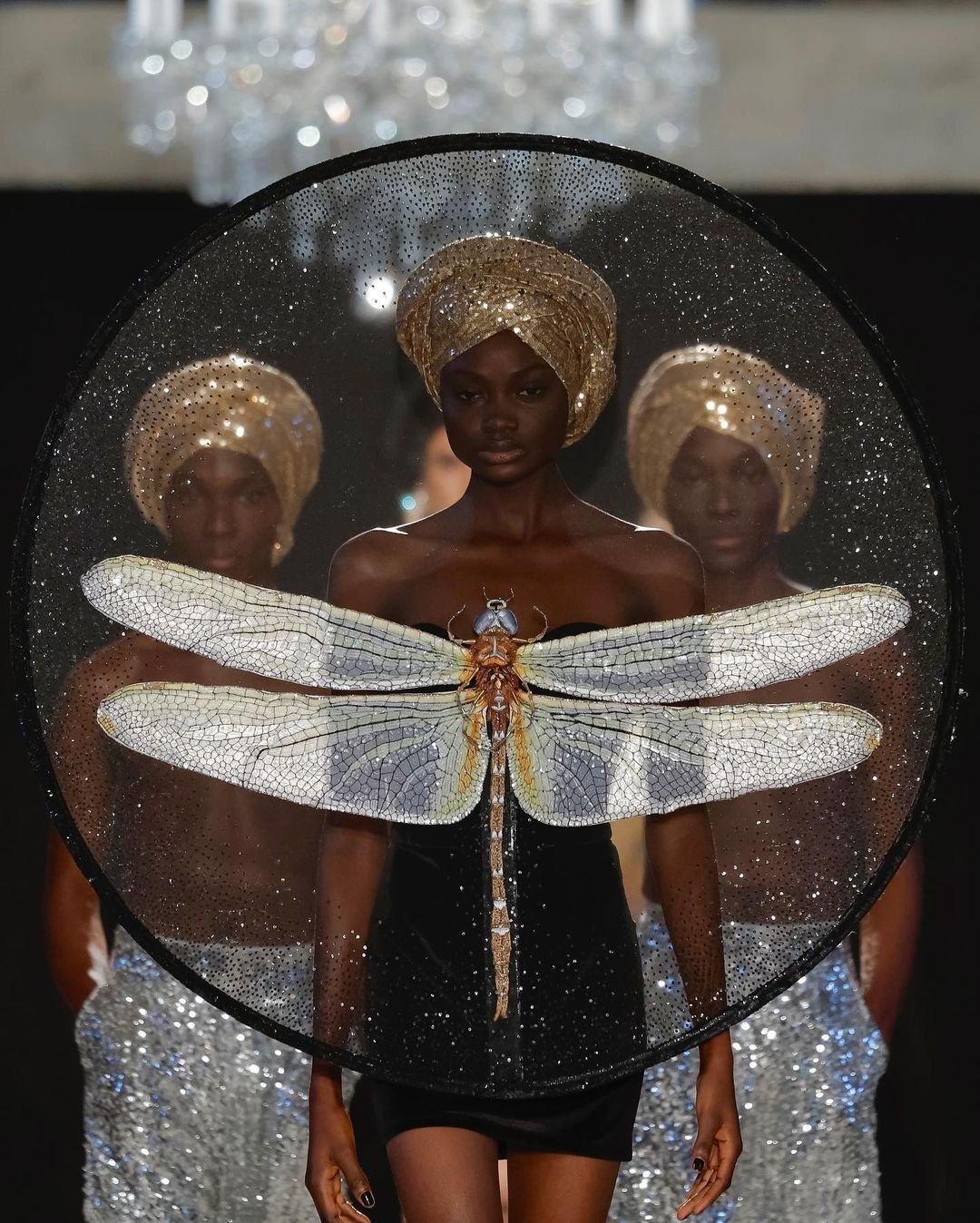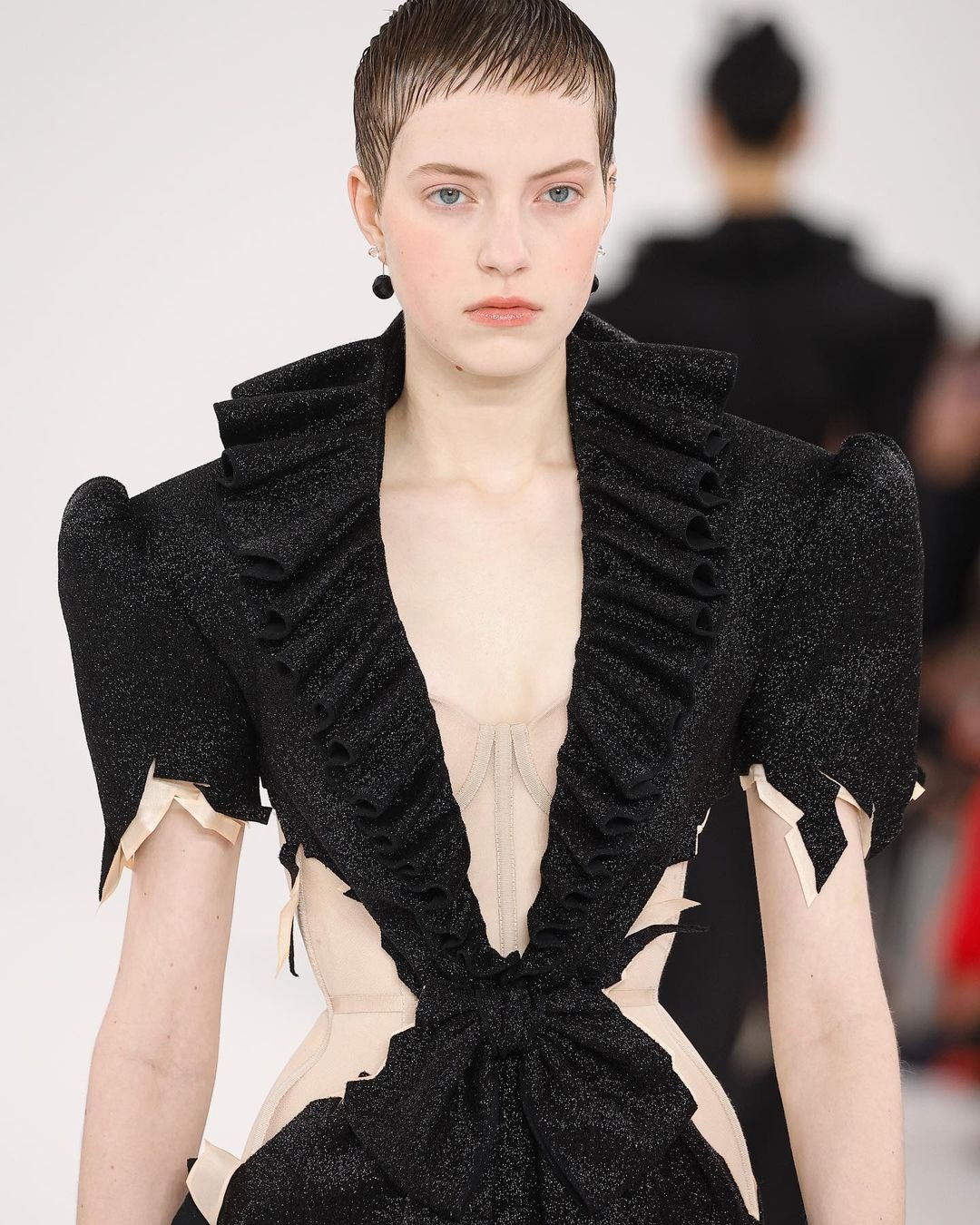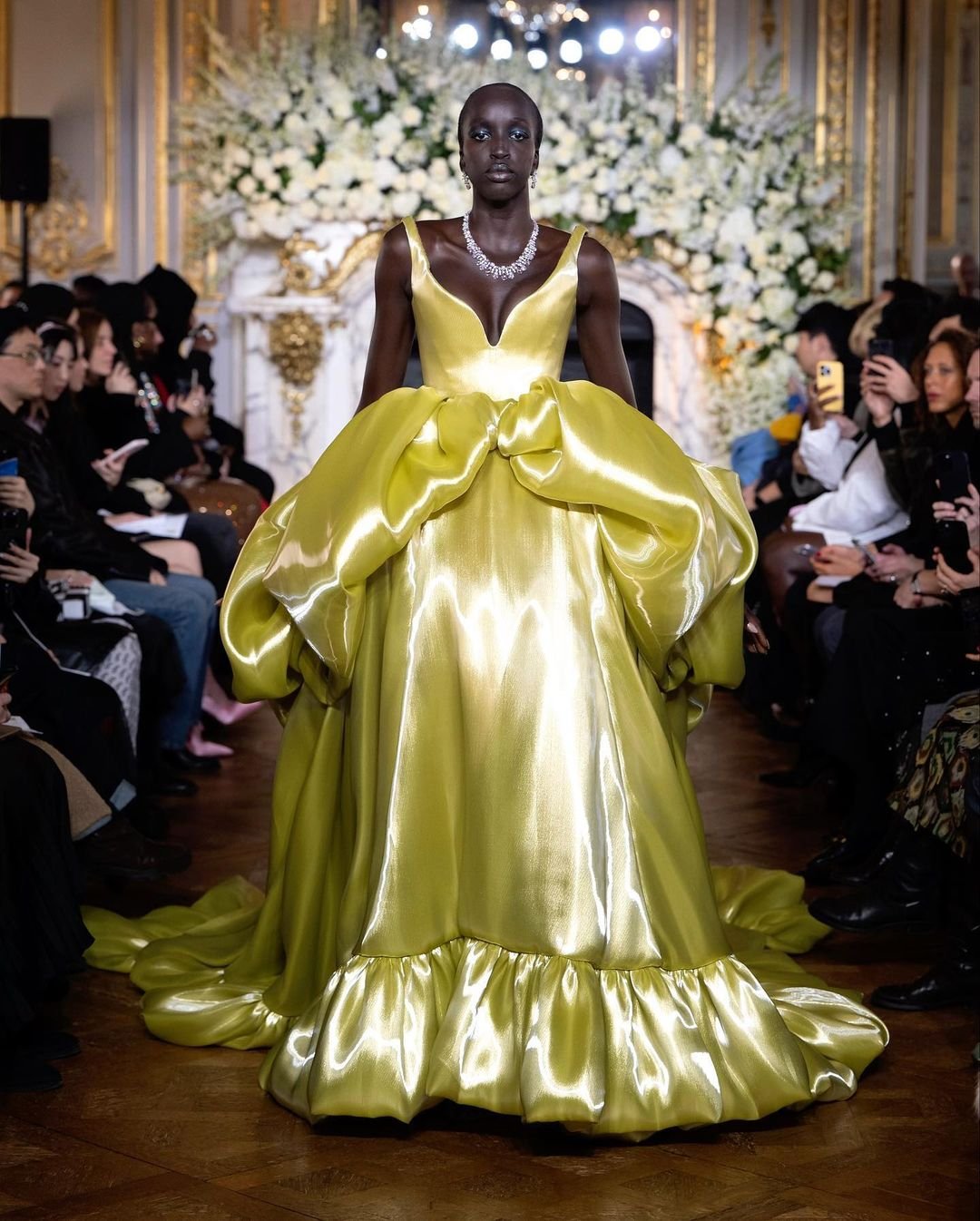text by Bliss Foster
1. When we look at designers that are clearly a once-in-a-lifetime talent, we recognize them because they do far more than just make outstanding work — the difference between them and any other hardworking and apt fashion designer is that they have the confidence to go so far against the grain and know that they will be rewarded for it. And in John Galliano’s case this season, he leaned so far into his universe and embraced ideas whose execution would horrify most. But by marching to the beat of his own drum and embracing pubic wigs, John Galliano has enabled Maison Margiela to break through to the most mainstream attention through his portrayal of the most seedy and debaucherous Paris. The sheerest garments appeared muddied and tattered, distorting our perception of the body in a manner no different than the corsets in this show that were wrenched tight on the models. It takes a lot of work to make a gross bar the setting of something beautiful, but Galliano’s vision is so effective that he redeems this uniquely Parisian genre of hedonism: taking us from literal tatters to haute couture. It’s no surprise that the glass skin makeup, keyed by the legendary Pat McGrath, has managed to sell out every single product whose effect on the skin would even approximate what she created for the show.
2. Simone Rocha’s stab at Jean Paul Gaultier couture was a large event for celebrities, which is a largely unexpected audience for the cult following of the coquette brand. But the standard JPG audience seemed thrilled - Simone’s clothing has that effect on people. Even if you’re not the kind of person that is inherently attracted to the overtly feminine, in the hands of Simone Rocha, bows become tears and frilly dresses can become a part of showcasing your cheerless attitude. Making exuberant clothing for people who can never be as spirited as their outfit implies is beautifully complex. The JPG cone bra is given a lift, turning into spiky rose thorns. Jean Paul’s tattoo exploration from Spring 1994 is reinterpreted into a sheer, organza pannier dress, trimmed with snakes, thorny branches, and roses. It’s not Rocha’s work without jewels and crystals, which created the structure of many tulle looks, but were notably present as eyeshadow and eyebrow adornment on the faces of many models. Likewise, it’s not a JPG show without the Marinière, whose stripes this season were piped with twisting bows made of navy satin ribbon. One of my favorite details were the sock-bun earrings, wrapped in hair.
3. A poem accompanied Rahul Mishra’s couture show this season and, put succinctly, it was about appreciating the small things in life. The whole collection centered around this theme, further emphasized by the beautiful cards on the showgoers’ seats that listed the near extinction of many species of moth and butterfly. Couture has a radically different pace than the ready-to-wear calendar, and part of that includes a strange slowing down. When you have a chance to slow down, you can appreciate the incredibly intricate details that make Rahul Mishra’s haute couture such a compelling endeavor, while also digesting his discussion on biodiversity and the preservation of nature. The sheer circular shields carried by the models appear to invite us to look through the lens of a microscope and see the details of a dragonfly, a hive of bees, and the intricate patterns of a close-up honeycomb whose inspiration is spread across the entire collection. Honeycomb became crystal grids which were found on the most exciting looks in the collection.
4. The couture of Viktor and Rolf’s only raison d’etre is to bother purists who clutch their pearls about the beauty, grace, and exactitude of couture, and that is meant in the absolute best way possible. What makes V&R so special is their ability to communicate exactly what couture stands for in their luxurious, precise work, while thematically bucking every haute couture convention. The distinctive sound of scissors was turned into a walkable beat, while four looks traced the evolution of a gradual destruction and reconstruction via the very scissors the audience could hear loudly snapping away. Deconstruction itself is not easy to do well, thousands of designers try and fail at creating compelling designs through the use of deconstruction. Turning deconstruction into a sliding scale however is an entirely different goal. The in-between looks seem to capture the process of how they were created surprisingly well, but are also decorated with the motif of child-like scissor destruction, covered in the most lovely and professionally finished jagged holes.
5. Volume looks effortless when Gaurav Gupta does it, delicately swirling about the wearer, but this was a less voluminous show than usual for the brand. This season’s showing included evening jackets, trench coats and bronze bustiers, grounding this collection in a wearability that is not often seen in couture presentations. Gaurav’s devotees were dressed to the nines in his work, of course. It’s rare to see couture look so effortless and stunning on folks who aren’t walking a runway.
6. Miss Sohee’s couture radically modernizes the public’s expectation of what couture can look like. Yet, Sohee Park’s vision seems rooted in the most antiquated and vintage inspirations. Her collection was inspired by the old South Korean antiques she seems to adore, but it seems more than just inspiration. Each look appears to personify a particular and individual antique, and in this way, each look feels like a loveable, household object from Beauty and the Beast after they come to life. The cohesion in this collection is spectacularly strong while maintaining a large variety between the looks, almost as if the looks themselves are a perfectly curated shelf of objects. If Cristobal was alive today, it’s possible that some shapes in this collection would stir up some envy, most notably in the chartreuse-colored lamé gown.
7. Robert Wun’s fantasy horror show is sharp in all the right places. It’s a literal sharpness in the busts, peplums and some shoulders of these horror storybook characters. But more impressively, the execution of this collection left no detail unattended to, nothing was out of place. It’s not often you see such precision in just runway looks - usually that precision is much more expected, really demanded, in product. But being so up close to Robert Wun’s work reinforced a professionalism and an attention to detail that has left a lot to be desired from other couturiers. Every element was immovable and complete, a standard to only ever expect from the major luxury houses, and a standard that is often unfair to place onto emerging designers. But Robert Wun has been in business for 10 years, and he has experienced career highlights that emerging designers could only dream of.

